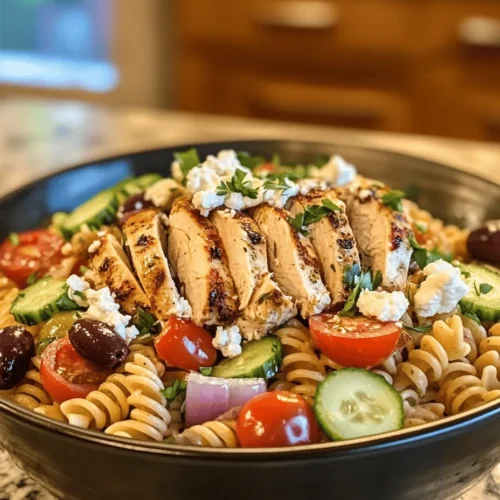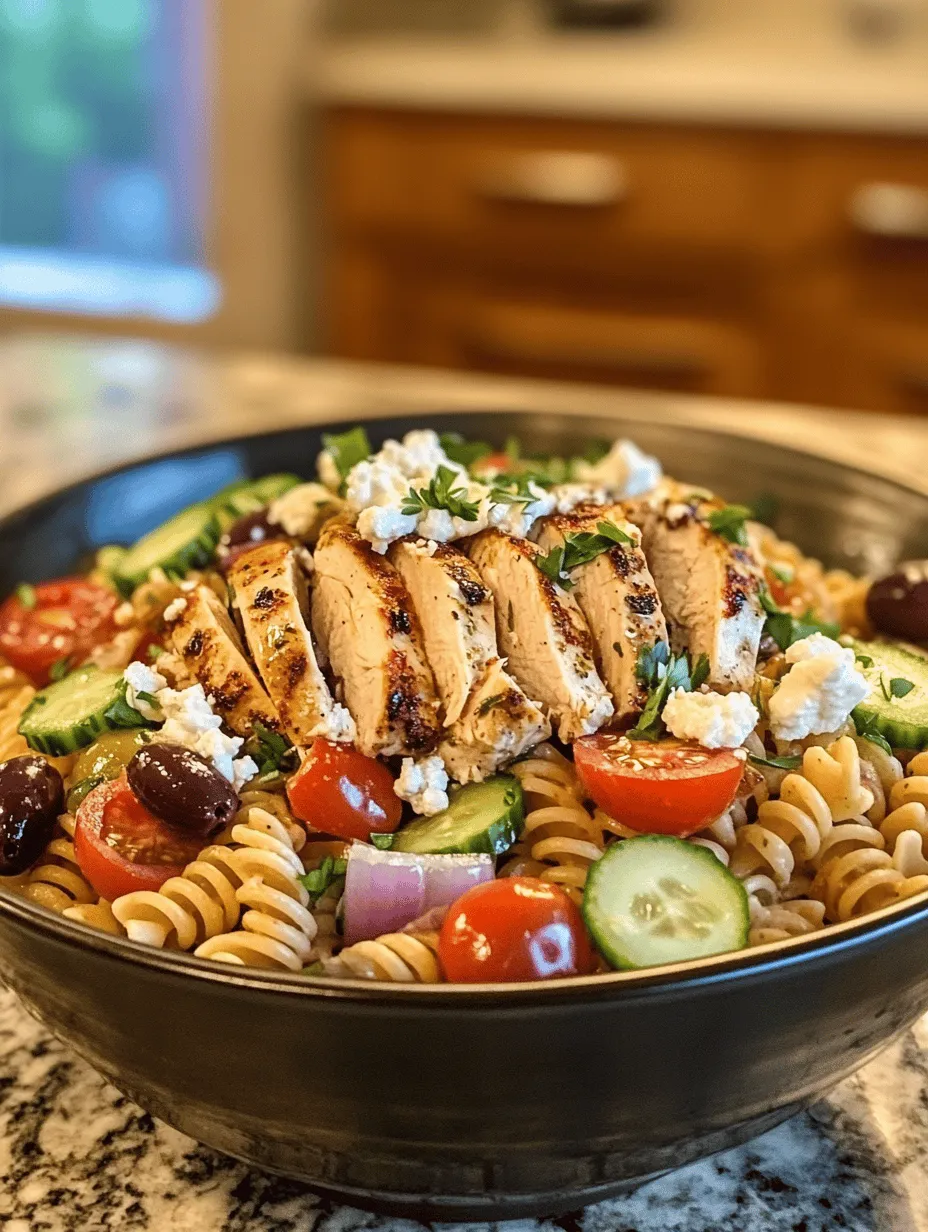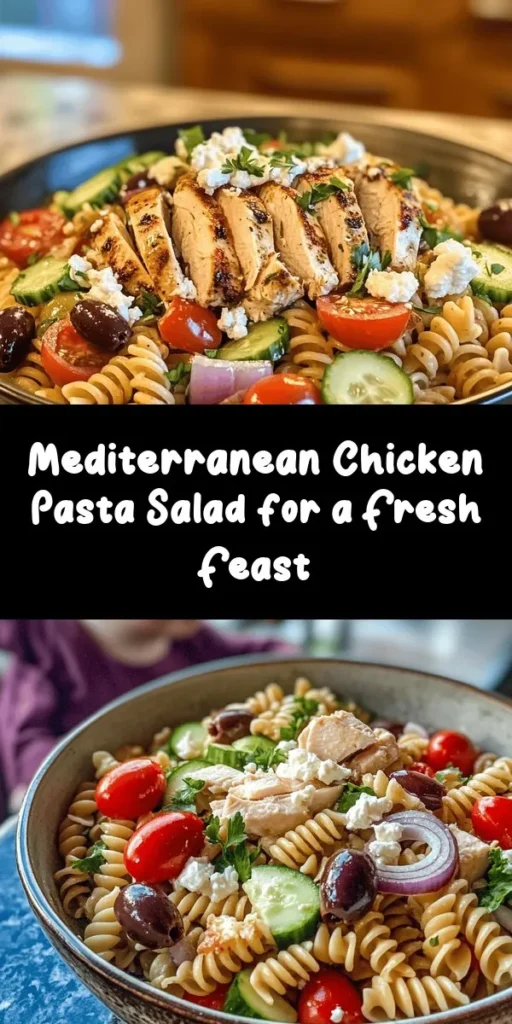Introduction
Mediterranean cuisine is celebrated not only for its vibrant flavors and diverse ingredients but also for its numerous health benefits. Originating from countries bordering the Mediterranean Sea, this culinary tradition embraces fresh produce, whole grains, lean proteins, and healthy fats, making it a staple for those seeking a balanced and nutritious diet. Among the plethora of Mediterranean dishes, the Mediterranean Chicken Pasta Salad stands out as a refreshing, wholesome option that is perfect for a variety of occasions—whether it’s a light lunch, a picnic at the park, or a delightful side dish for your next barbecue.
This salad is an exquisite symphony of flavors and textures, combining tender chicken, al dente pasta, crisp vegetables, and the tangy richness of feta cheese. Each bite offers a burst of freshness, making it not just a meal but an experience that transports you straight to the sun-drenched shores of the Mediterranean. With its easy preparation and versatility, this Mediterranean Chicken Pasta Salad is sure to become a beloved recipe in your culinary repertoire.
Understanding the Ingredients
To create the perfect Mediterranean Chicken Pasta Salad, it’s essential to understand the role of each ingredient in contributing to the dish’s overall flavor, texture, and nutritional profile.
Key Ingredients
1. Chicken Breast: As a primary protein source, chicken breast is a lean meat that is low in fat and high in protein, making it an excellent choice for maintaining muscle mass and promoting satiety. Cooking it properly ensures that it remains juicy and tender, forming a delicious base for the salad.
2. Pasta: This staple ingredient is a fantastic source of carbohydrates, providing energy to fuel your day. For this recipe, whole grain or whole wheat pasta can be used to increase fiber content and enhance nutritional value. Cooking the pasta to an al dente texture not only adds a satisfying chew but also helps the pasta to absorb the flavors of the dressing and other ingredients.
3. Fresh Vegetables: Cherry tomatoes, cucumbers, and red onions add vibrant color and crunch to the salad. Cherry tomatoes are rich in antioxidants, particularly lycopene, which has been linked to various health benefits. Cucumbers provide hydration and a refreshing crunch, while red onions add a hint of sharpness and depth of flavor.
4. Olives: A hallmark of Mediterranean cuisine, olives contribute healthy fats to the dish. They are also packed with antioxidants and have anti-inflammatory properties. The briny flavor enhances the overall taste of the salad, making each bite more complex and satisfying.
5. Feta Cheese: This crumbly cheese is not only delicious but also a great source of calcium and protein. Its tangy flavor complements the other ingredients beautifully, providing a creamy contrast to the crunchy vegetables and firm pasta.
6. Herbs and Spices: Fresh herbs like oregano and basil are essential for lifting the salad’s flavor profile. They are not only aromatic but also offer various health benefits, including digestive support and anti-inflammatory properties. Using dried herbs can also be effective, but fresh herbs provide a brighter, more vibrant taste.
Nutritional Profile
The Mediterranean Chicken Pasta Salad is not just a treat for your taste buds; it’s also a powerhouse of nutrients. The combination of lean protein from chicken, complex carbohydrates from pasta, and a plethora of vitamins and minerals from fresh vegetables creates a balanced meal that can support a healthy lifestyle. The inclusion of healthy fats from olives and feta cheese helps to keep you full longer while adding essential fatty acids that are beneficial for heart health.
Step-by-Step Preparation of Mediterranean Chicken Pasta Salad
Creating a Mediterranean Chicken Pasta Salad is a straightforward process that can be completed in just a few simple steps. Follow these detailed instructions to ensure that each component of your salad is perfectly cooked and flavorful.
Cooking the Pasta
1. Choose Your Pasta: For this recipe, you can choose any pasta shape you prefer; however, rotini or penne works particularly well as they hold onto the dressing and other ingredients.
2. Boil Water: Fill a large pot with water and add a generous amount of salt. Bring the water to a rolling boil. The salt enhances the pasta’s flavor as it cooks.
3. Cook to Al Dente: Add the pasta to the boiling water and cook according to the package instructions until it reaches an al dente texture. Al dente means “to the tooth,” and ensures that the pasta is firm yet tender. This step is crucial as overcooked pasta can become mushy and lose its ability to absorb the dressing.
4. Drain and Cool: Once cooked, drain the pasta in a colander and rinse it briefly under cold water. This halts the cooking process and helps cool the pasta down, making it ready to mix with the salad ingredients.
Cooking the Chicken
1. Prepare the Chicken Breasts: Take boneless, skinless chicken breasts and pat them dry with paper towels. This helps the seasoning adhere and promotes better browning.
2. Season Generously: Season both sides of the chicken with salt, pepper, and your choice of dried herbs (such as oregano and basil). You can also marinate the chicken in olive oil, lemon juice, and herbs for a few hours before cooking for added flavor.
3. Cook the Chicken: Heat a skillet over medium-high heat and add a drizzle of olive oil. Once hot, add the seasoned chicken breasts to the pan. Cook for about 6-7 minutes on each side, or until the internal temperature reaches 165°F (75°C). Using a meat thermometer is the most reliable way to check for doneness.
4. Rest and Slice: Once cooked, remove the chicken from the skillet and allow it to rest for a few minutes. This allows the juices to redistribute, keeping the meat moist. After resting, slice the chicken into bite-sized pieces.
Preparing the Vegetables
1. Wash and Slice: Rinse the cherry tomatoes and cucumbers under cold water. Halve the cherry tomatoes and dice the cucumbers into bite-sized pieces. For the red onion, thinly slice it to maintain a nice crunch and minimize overpowering flavors.
2. Mix and Chill: Combine the prepared vegetables in a large mixing bowl. If you prefer, you can chill the vegetables in the refrigerator for a short time to enhance their freshness.
Making the Dressing
1. Combine Ingredients: In a separate bowl, whisk together extra virgin olive oil, red wine vinegar (or lemon juice), Dijon mustard, salt, pepper, and a pinch of dried oregano. The olive oil serves as the base, while vinegar or lemon juice adds acidity, balancing the richness of the feta and olives.
2. Adjust to Taste: Taste the dressing and adjust the seasoning as necessary. If you prefer a tangier dressing, add more vinegar or lemon juice. For a creamier texture, you can incorporate a spoonful of yogurt or mayonnaise.
Combining Ingredients for Maximum Flavor
Once all the components are prepared, it’s time to bring everything together. In a large bowl, combine the cooled pasta, sliced chicken, prepared vegetables, olives, and crumbled feta cheese. Drizzle the dressing over the top and toss gently to combine, ensuring that each ingredient is well coated with the flavorful dressing.
As you mix, take care not to crush the feta cheese or overmix the pasta to maintain the integrity of the ingredients. Allow the salad to sit for a few minutes to let the flavors meld before serving. This Mediterranean Chicken Pasta Salad can be enjoyed immediately or stored in the refrigerator for later, making it a versatile dish that fits into any schedule.
Stay tuned for the next part of our Mediterranean Chicken Pasta Salad article, where we will explore additional tips for enhancing the dish and answer some common questions about this delightful recipe.

Guidelines on How to Combine Salad Ingredients Effectively
Combining the ingredients for your Mediterranean Chicken Pasta Salad is a crucial step that can significantly impact the overall flavor and texture of the dish. To achieve a harmonious blend of flavors, start by adding the cooked pasta to a large mixing bowl. Make sure the pasta is cooled to room temperature to prevent wilting the fresh ingredients.
Next, gently fold in the chopped cooked chicken. Opt for grilled or roasted chicken for a depth of flavor; avoid boiling it, as this can result in a bland taste. Follow this by adding your chopped vegetables, such as cucumbers, cherry tomatoes, red onion, and bell peppers. These ingredients not only add color but also a refreshing crunch.
To enhance the flavor profile, sprinkle in your herbs—fresh parsley and basil work wonderfully. Finally, drizzle your prepared dressing—typically a mix of olive oil, lemon juice, garlic, and Italian seasoning—over the salad. Toss everything together with care, making sure each ingredient is coated in dressing without breaking the pasta or vegetables.
Importance of Allowing the Salad to Rest
Once you have combined all the salad ingredients, it’s essential to let the salad rest for at least 30 minutes before serving. This resting period allows the flavors to meld beautifully. The olive oil and lemon juice will penetrate the ingredients, enhancing the overall taste. Additionally, resting helps the vegetables soften slightly, making for a more pleasant eating experience without losing their crunch altogether.
Consider texture as well; freshly mixed salads can sometimes feel disjointed. Allowing the salad to rest ensures a more cohesive blend, where every bite provides a delightful combination of flavors and textures.
Suggestions on How to Layer the Salad for Visual Appeal
If you want to impress your guests visually, consider layering the salad in a large glass bowl or individual serving cups. Start with a layer of pasta at the bottom, followed by a layer of chicken, then a colorful layer of vegetables, and finally, a sprinkle of herbs and dressing. This method not only looks stunning but also helps in keeping the ingredients distinct until served.
To elevate the visual appeal further, you could sprinkle crumbled feta cheese on top or add a few olives for garnish. The contrasting colors of the bright vegetables against the neutral pasta and chicken create an inviting presentation, perfect for gatherings or special occasions.
Serving Suggestions and Variations
This Mediterranean Chicken Pasta Salad is versatile enough for various occasions. It shines at summer picnics, potlucks, or even as a meal prep option for weekly lunches. Pair it with a light white wine or a refreshing sparkling water for an ideal summertime meal.
For those with dietary preferences, there are numerous variations to consider. To make a vegetarian option, substitute the chicken with chickpeas or roasted vegetables. For a vegan salad, consider using a plant-based pasta and omitting the cheese or using a vegan alternative.
If gluten is a concern, simply swap standard pasta for gluten-free options made from rice, quinoa, or lentils. You can also get creative by adding ingredients like artichokes, roasted red peppers, or even avocado to enhance the flavor and texture of the salad. These additions not only complement the Mediterranean theme but also pack in more nutrients.
Storing and Reheating Mediterranean Chicken Pasta Salad
Storing your Mediterranean Chicken Pasta Salad properly ensures that leftovers remain fresh and delicious. Place the salad in an airtight container and store it in the refrigerator. It’s best to consume the salad within 3 to 5 days, as the fresh ingredients can start to wilt and lose their texture over time.
If you find that the salad has become dry after storage, don’t worry. Simply add a splash of olive oil or lemon juice to refresh it. Gently mix, and you’ll find that the flavors revive beautifully. Avoid reheating this salad in the microwave, as the texture of the pasta and vegetables may suffer; it is best enjoyed cold or at room temperature.
Health Benefits of Mediterranean Chicken Pasta Salad
The Mediterranean diet is well-known for its health benefits, incorporating whole foods, healthy fats, and plenty of fruits and vegetables. This Chicken Pasta Salad aligns perfectly with those principles, providing a balanced meal rich in nutrients.
A typical serving of this salad contains approximately 350-450 calories, depending on the portion size and additional ingredients. It offers a healthy dose of protein from the chicken, healthy fats from olive oil, and a variety of vitamins and minerals from the vegetables. The fiber content from the pasta and vegetables aids digestion and keeps you feeling full longer, making it a wholesome addition to your diet.
Incorporating this dish into your weekly meal plan can support overall health, help maintain energy levels, and promote a balanced intake of essential nutrients.
Conclusion
In conclusion, the Mediterranean Chicken Pasta Salad is not only a nutritious and delicious dish but also a versatile option that can cater to various dietary needs and preferences. Its vibrant colors and rich flavors make it an appealing choice for any occasion, from casual gatherings to formal dinners.
I encourage you to try making this recipe at home, experimenting with different ingredients and variations to suit your taste. Embrace the joy of cooking and sharing meals with others, as food has a unique way of bringing people together. Enjoy the flavors of the Mediterranean and the satisfaction of creating a wholesome dish that delights your palate and nourishes your body.



